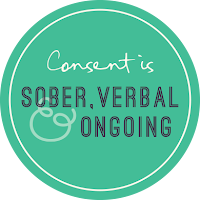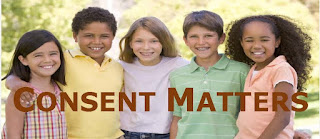Learning about boundaries and consent is a process that takes place over many years. By starting the conversation early, your children have more time to internalize body-safety rules and practice setting boundaries. And likewise, by talking with caregivers and family members about boundaries, you can model for your child, and the adults in their lives, what consent looks like and that it matters.
In this article, I will discuss how to talk about consent with caregivers and family members, younger children, and with teens, and will give you sample language for doing so.
Giving Children Choice Around Affection & Modeling Consent
Seize every opportunity to model consent for your children — and actively support them in giving their own consent around touch. Allow children to choose if, when, and with whom they show affection.
A child who can say “No” to a loved one in a safe environment has a better chance of saying “No” if approached in an unsafe situation. For this reason, I recommend asking children before showing affection. For instance, you might ask, “May I have a kiss?” or “Do you want a hug?”
When you ask, and a child grants or denies permission, you are empowering your child to be the boss of his or her own body. If nothing else, read your child’s body language. If your child resists your hug, that’s actually a good thing because your child is asserting his/her own boundary and that’s what you want your child to be able to do if ever in an unsafe situation. You can turn this into a teachable moment by saying:
“If you don’t want a hug, that’s fine because you are the boss of your body. When you want a hug or a kiss, let me know.”
A young child typically will rush over and give you a hug because he or she feels empowered! I know how natural it is for parents and grandparents to want to shower their children and grandchildren with hugs and kisses. But giving a child a choice about physical affection teaches that consent matters.
Also invite caregivers to think about boundaries by sharing your child’s body-safety rules:
- My child is the boss of his/her body.
- We teach our children body-safety rules.
- We teach our children to respect adults, but it’s okay for them to say “no” and tell if they ever feel unsafe.
- Our children do not keep secrets.
But what about Auntie Irma who demands her hug, believes that your child owes her a hug and tells your child she’ll be so sad without a hug? Teach Auntie Irma “the why behind” this body-safety rule, that by teaching your children about consent when they are young, with all the people in their lives, they learn early that it is not their responsibility to manage the feelings of others.
With other adults, you might turn consent into a conversation about matching expectations before kids have a playdate. With babysitters, you might pose some discussion questions – e.g.,
“How would you respond to my children grabbing each other’s private parts while bathing?” and “What would you do if my daughter asked you to tickle her?”
Every time you speak up, you are helping to keep your child safe from sexual abuse and modeling the practice of consent, which will help your child for a lifetime.
Talking with Younger Children about Boundaries
You can start teaching children about consent as soon as they are able to understand basic rules and right from wrong. When talking with younger children (chronologically or mentally), be concrete, and use practice and repetition to help with learning.
Here are five body-safety rules you can teach young children about boundaries, the foundation of consent.
- No one is allowed to touch your private parts unless you need help cleaning them, or your private parts are hurt or sick and the doctor or nurse needs to examine them.
- It is not okay to touch someone else’s private parts.
- No one is allowed to take pictures of your private parts or of you doing anything while you’re naked, e.g., going to the bathroom, bathing, or dressing. (This body-safety rule is not meant to prevent parents from taking a photo of their kids in the tub to share with grandma, but is important toward preventing someone from using children for pornographic purposes, which will be the subject of the January newsletter.)
- If somebody tries to touch your private parts, say “no,” try to get away, and tell.
- “No one is allowed to make you hug or kiss them if you do not want to. No one is allowed to hug or kiss you if you don’t want them to.
And remember to also teach your children that consent is a two-way street. Some kids are super affectionate and will hug and kiss everyone they see. This is a great opportunity to teach kids that they must receive permission from others to give hugs and kisses.
Implicit in all of these rules is the concept that everyone is the boss of his or her body.
Your children will give you ample opportunities to naturally bring up and reinforce these rules. For instance, when you’re washing your toddler’s private parts you might say:
“Mommy is going to clean your penis and testicles now. Remember, no one is allowed to touch your penis, unless you need help cleaning it, which is what I’m doing right now.”
Here’s another example – a four-year-old girl who is touching her vagina while watching TV. Here you might say:
“Since you’re the boss of your body, it’s always OK for you to touch and look at your own private parts, as long as you do it in private when no one else is around.”
Now consider these scenarios and what you might say. We’ll be talking about each one on Facebook in the coming days, so join the discussion.
- Changing your baby’s diapers:
- Two kids playing in a wading pool and grabbing each other’s private parts:
- Older sibling grabs cell phone to take photo of naked younger sibling:
- Dad showering with son or daughter:
- Daddy, is that your tail?
Lastly, it is also important to teach children that if someone does touch their private parts, it is never ever their fault — and they can talk with you about it.
Shame permeates the crime of sexual assault, and is often the reason why people don’t tell for years and years (and sometimes ever). Survivors often believe it was their fault. The abuser counts on this, so we have to remind every child and the adult they become that child sexual abuse is never their fault. Children can never give consent to sexual touch!
For more information about keeping kids safe from sexual abuse, including a complete set of body-safety rules, see Off Limits: A Parent‘s Guide to Keeping Kids Safe from Sexual Abuse.
Talking with Teens about Consent
When talking with teens, you can use more abstract terms like “consent” and “exploitation,” and guidelines such as “Trust your intuition” and “Set sexual boundaries.”
- No one has the right to touch the private areas of your body without your permission. No one has the right to force, coerce, threaten, or manipulate you into engaging in any type of sexual activity.
- You don’t have the right to touch someone else’s private areas of their body without that person’s permission. And it’s never acceptable to force, coerce, bribe, threaten, or manipulate another person into any type of sexual activity. With teens it’s also important to discuss the legal ramifications of sexually assaultive behaviors.
- It’s a crime for any person (child, teen or adult) to take photos or videos of your naked body. If any person ever tries to take a photo of your private parts or naked body, refuse and tell a parent or trusted adult. Also be sure that your child knows that “sexting” – sending nude photos by cell phone – is illegal.
 |
| Credit: Brookdale Community College |
For a more detail discussion of these and other body-safety rules, see my book: Off Limits!
One of the best ways to educate teens and reinforce body-safety rules is through “What-if” games because they lead to meaningful discussions with your child about hypothetical yet real situations.
- What if you’re at a party and someone makes an unwanted sexual pass at you? What would you say and do?
- What if you’re drinking and you’re not able to advocate well for yourself?
- What if you see a friend or peer struggling to get away from someone? What would you say or do?
- What if someone you don’t know very well wanted to take photos of your body, saying you could become a famous model?
- What if you’re spending the night at a friend’s house and the friend’s older sibling or father walks around naked? What would you say or do?
- What if someone you’re interested in starts sexting?
- What if you agree to kiss someone and then the person you’re with starts pulling up your shirt or unzipping your pants?
When talking with teens and young adults, make sure they understand what consent really means and what it looks like in practice.
Consent is an agreement between people to engage in sexual activity. And in a consensual agreement, you can change your mind any time. This means just because you consent to kissing doesn’t mean you’re consenting to anything else.
Consent can be verbal or nonverbal, but verbal is preferred because it requires one party to ask and the other party to agree. RAINN.org offers these examples of what consent does and does not look like.
Positive consent can look like this:
- Communicating when you change the type or degree of sexual activity with phrases like “Is this OK?”
- Explicitly agreeing to certain activities, either by saying “yes” or another affirmative statement, like “I’m open to trying.”
- Using physical cues to let the other person know you’re comfortable taking things to the next level
 Equally important is what consent does NOT look like:
Equally important is what consent does NOT look like:
- Refusing to acknowledge “no”
- Assuming that wearing certain clothes, flirting, or kissing is an invitation for anything more
- Someone being under the legal age of consent, as defined by the state
- Someone being incapacitated because of drugs or alcohol
- Pressuring someone into sexual activity by using fear or intimidation
- Assuming you have permission to engage in a sexual act because you’ve done it in the past




Leave a Reply